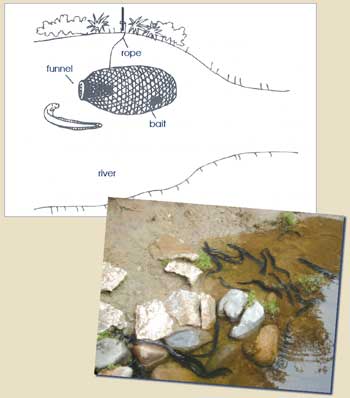|
|||||||||||||||
|
|||||||||||||||
%
responses 2008 ('04) |
|||||||||||||||
y8 |
|||||||||||||||
| Rope: (to hold trap in place) |
identified and explained |
49 (61) |
|||||||||||||
not identified, but explained |
2 (2) |
||||||||||||||
identified (arrow drawn) |
20 (16) |
||||||||||||||
| Funnel: (to let eel in but not out) |
identified and mentioned trapping effect |
31 (27) |
|||||||||||||
not identified, but mentioned
trapping effect |
1 (2) |
||||||||||||||
identifed and mentioned lets eels in |
38 (44) |
||||||||||||||
not identified, but mentioned lets eels in |
4 (6) |
||||||||||||||
identified only, no adequate explanation |
10 (10) |
||||||||||||||
| Bait: (to entice eel into trap) |
identified and explained |
74 (70) |
|||||||||||||
not identified, but explained |
3 (1) |
||||||||||||||
identified (arrow drawn) |
8 (10) |
||||||||||||||
| Netting: (see or smell bait/keep eels inside/ allow water to flow through) |
identified and explained |
22 (22) |
|||||||||||||
not identified, but explained |
0 (0) |
||||||||||||||
identified (arrow drawn) |
5 (10) |
||||||||||||||
Total
score: |
8–9 |
10 (10) |
|||||||||||||
6–7 |
40 (49) |
||||||||||||||
4–5 |
32 (27) |
||||||||||||||
2–3 |
16 (12) |
||||||||||||||
0–1 |
3 (2) |
||||||||||||||
| Subgroup Analysis [Click on charts to enlarge] : |
| Commentary: |
| Most students had a basic understanding of how the eel trap worked and could explain some of the essential features of the trap. There were minimal gender differences in performance, nor much change from 2004 to 2008. |

